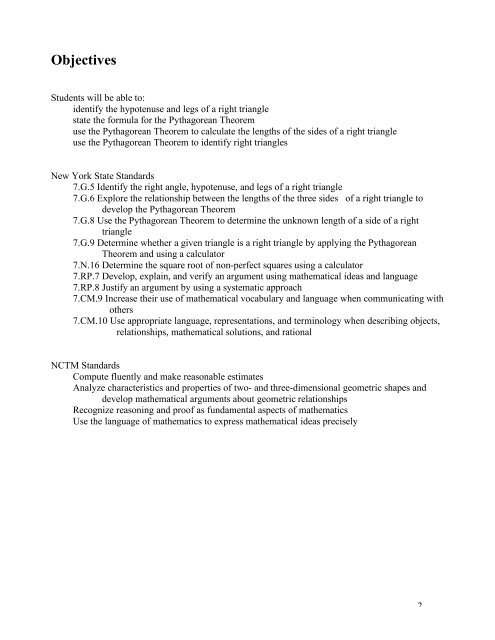Pythagorean Theorem Differentiated Instruction for Use in an ...
Pythagorean Theorem Differentiated Instruction for Use in an ...
Pythagorean Theorem Differentiated Instruction for Use in an ...
You also want an ePaper? Increase the reach of your titles
YUMPU automatically turns print PDFs into web optimized ePapers that Google loves.
Objectives<br />
Students will be able to:<br />
identify the hypotenuse <strong>an</strong>d legs of a right tri<strong>an</strong>gle<br />
state the <strong>for</strong>mula <strong>for</strong> the <strong>Pythagore<strong>an</strong></strong> <strong>Theorem</strong><br />
use the <strong>Pythagore<strong>an</strong></strong> <strong>Theorem</strong> to calculate the lengths of the sides of a right tri<strong>an</strong>gle<br />
use the <strong>Pythagore<strong>an</strong></strong> <strong>Theorem</strong> to identify right tri<strong>an</strong>gles<br />
New York State St<strong>an</strong>dards<br />
7.G.5 Identify the right <strong>an</strong>gle, hypotenuse, <strong>an</strong>d legs of a right tri<strong>an</strong>gle<br />
7.G.6 Explore the relationship between the lengths of the three sides of a right tri<strong>an</strong>gle to<br />
develop the <strong>Pythagore<strong>an</strong></strong> <strong>Theorem</strong><br />
7.G.8 <strong>Use</strong> the <strong>Pythagore<strong>an</strong></strong> <strong>Theorem</strong> to determ<strong>in</strong>e the unknown length of a side of a right<br />
tri<strong>an</strong>gle<br />
7.G.9 Determ<strong>in</strong>e whether a given tri<strong>an</strong>gle is a right tri<strong>an</strong>gle by apply<strong>in</strong>g the <strong>Pythagore<strong>an</strong></strong><br />
<strong>Theorem</strong> <strong>an</strong>d us<strong>in</strong>g a calculator<br />
7.N.16 Determ<strong>in</strong>e the square root of non-perfect squares us<strong>in</strong>g a calculator<br />
7.RP.7 Develop, expla<strong>in</strong>, <strong>an</strong>d verify <strong>an</strong> argument us<strong>in</strong>g mathematical ideas <strong>an</strong>d l<strong>an</strong>guage<br />
7.RP.8 Justify <strong>an</strong> argument by us<strong>in</strong>g a systematic approach<br />
7.CM.9 Increase their use of mathematical vocabulary <strong>an</strong>d l<strong>an</strong>guage when communicat<strong>in</strong>g with<br />
others<br />
7.CM.10 <strong>Use</strong> appropriate l<strong>an</strong>guage, representations, <strong>an</strong>d term<strong>in</strong>ology when describ<strong>in</strong>g objects,<br />
relationships, mathematical solutions, <strong>an</strong>d rational<br />
NCTM St<strong>an</strong>dards<br />
Compute fluently <strong>an</strong>d make reasonable estimates<br />
Analyze characteristics <strong>an</strong>d properties of two- <strong>an</strong>d three-dimensional geometric shapes <strong>an</strong>d<br />
develop mathematical arguments about geometric relationships<br />
Recognize reason<strong>in</strong>g <strong>an</strong>d proof as fundamental aspects of mathematics<br />
<strong>Use</strong> the l<strong>an</strong>guage of mathematics to express mathematical ideas precisely<br />
2

















